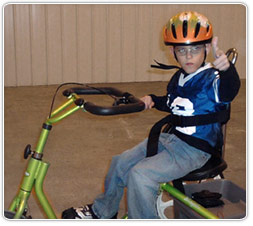
Families and physical therapists value adaptive tricycles for both recreational and therapeutic reasons. But will third party payers understand the medical necessity, and support purchase of this equipment? The following information may be of use to therapists in providing medical justification for adaptive tricycles.
One major problem affecting the function and health of children with Cerebral Palsy (CP) is weakness and resultant lack of physical activity. Historically, exercise to promote physical fitness and strengthening were discouraged for children with spasticity, due to the concern that the spasticity and abnormal movement patterns would be enhanced. Current research, however, indicates that resistive exercise does in fact improve strength and function for children with CP.
Inactivity for children with CP may contribute to the development of secondary conditions associated with CP such as joint contractures, osteoporosis, and decreased respiratory and circulatory function. Active exercise and physical fitness can help prevent these secondary conditions. There is increasing recognition of the medical necessity of providing these children with a means of active exercise at school and at home. Parents and family are supportive of these perspectives.
Rifton Equipment manufactures three sizes of an adaptive tricycle, designed so that they do not require significant balance or skilled motor ability on the part of the user. For this reason, adaptive cycling is an ideal exercise for children with CP. Tricycling has the potential to improve strength and cardio-respiratory fitness for walking endurance, gross motor function, and health related quality of life.
Research studies focusing on the use of tricycles as an exercise activity for children with CP have resulted in supportive evidence for this intervention, for both muscle activation and function. Further research on adaptive cycling as a medical intervention is needed and is under development.
In order to successfully obtain funding for an adaptive tricycle through medical justification, it is important to prove the medical necessity. One means for this, is to describe it as a therapeutic mobility device, and to detail the therapeutic benefits.